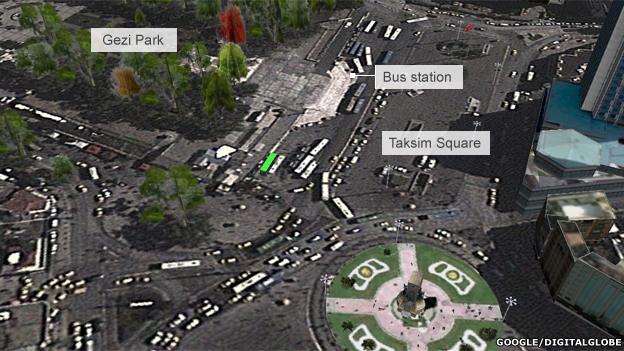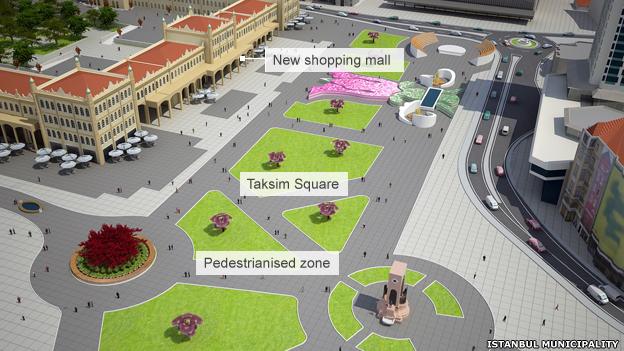Turkey clashes: Why are Gezi Park and Taksim Square so important?
- Published
Plans to redevelop Istanbul's Gezi Park into a complex with new mosque and shopping centre have sparked a wave of protests in the Turkish city and beyond.
But what began as a demonstration against urban redevelopment has turned into a wider expression of anger against government policies. The excessive use of force by riot police has escalated tensions.
Gezi Park and Taksim Square: How they look now

Gezi Park - an area inside Taksim Square, filled with sycamore trees - is one of the few green spaces left in central Istanbul.
It has been compared with Cairo's Tahrir Square - the focus of the demonstrations which toppled President Hosni Mubarak in 2011 - and protesters' banners claim that redeveloping the park is akin to the commercial takeover of Central Park in New York, or Hyde Park in London.
Under the redevelopment plans, the government wants to pedestrianise and ease traffic around Taksim Square, which effectively means much of Gezi Park will be replaced by concrete.
Gezi Park and Taksim Square: The plans

Protesters are angry about the removal of green space. They also claim that access to the square will become increasingly controlled, giving pedestrians only two entry points.
The redevelopment plans include the construction of a shopping centre, which Prime Minister Recep Tayyip Erdogan insists will not be "a traditional mall" but will include cultural centres, an opera house and a mosque.
An Ottoman-era military barracks will be rebuilt near the site, and the historic Ataturk Cultural Centre will be demolished.
But critics say the decision to go ahead with the redevelopment was made too fast and without proper public and media debate.
There are also questions over the choice of Kalyon Group, a company which has close ties with the governing Justice and Development (AK) Party, as the project's main contractor.
For some Turks, the proposed reconstruction of the barracks has a symbolic significance. According to some accounts, it was at the barracks that a (failed) mutiny by Islamic-minded soldiers was initiated in 1909 intent on bringing in Sharia law.
The barracks were demolished in 1940, and attempts to rebuild them are seen by opponents to have the ring of Islamism.
This protest has now become about more than just Gezi Park.
It has broadened into a wider expression of anger at what protesters see as the government's increasing authoritarianism - and also the heavy-handed tactics of police who used tear gas and water cannon to disperse a peaceful rally, resulting in scores of injuries.
Taksim Square has seen several other demonstrations this year, including one on May Day in which police also fired tear gas at protesters.
- Published3 June 2013
- Published3 June 2013
- Published2 June 2013
- Published3 June 2013